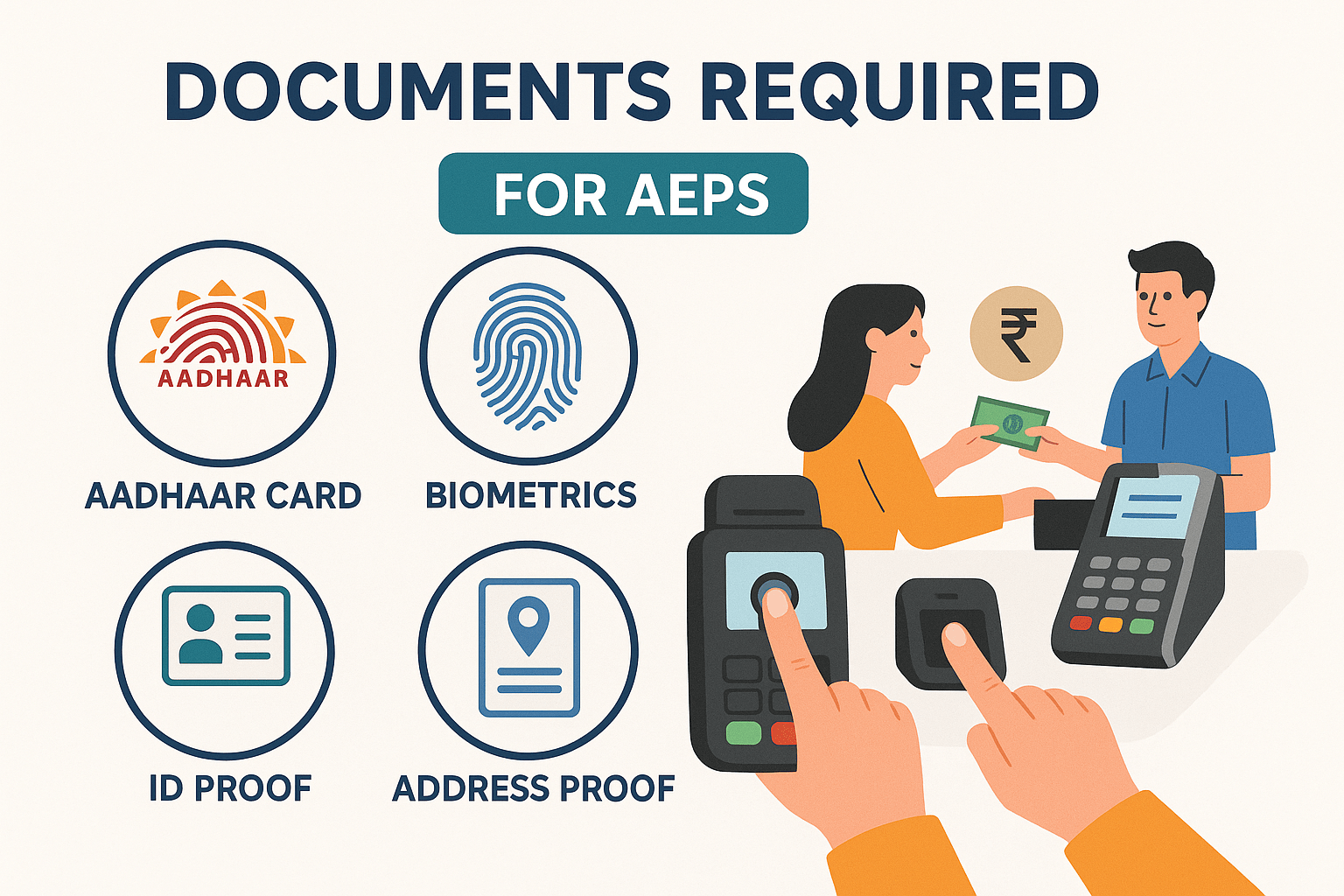Aadhaar Enabled Payment System (AEPS) has revolutionized banking in (Documents Required to Use AEPS) India by enabling cashless transactions using just an Aadhaar number and biometric authentication. Whether you’re a customer looking to withdraw money or a merchant offering AEPS services, knowing the documents required for AEPS is crucial for smooth transactions.
In this guide, we’ll break down the essential documents needed for both customers and merchants, along with key insights to help you navigate the process effortlessly.
What is AEPS?
AEPS is a secure, UIDAI-approved payment system that allows users to perform basic banking transactions—such as cash withdrawals, balance checks, and fund transfers—using their Aadhaar number and fingerprint authentication. It eliminates the need for physical cards or remembering PINs, making banking accessible even in rural areas.
Now, let’s explore the documents required for AEPS based on whether you’re a customer or a merchant.
Documents Required for Customers to Use AEPS
To use AEPS services, customers must provide minimal documentation. Here’s what you need:
1. Aadhaar Card (Mandatory)
Your Aadhaar number is the primary requirement for AEPS transactions. It serves as your identity proof and is linked to your bank account for authentication.
2. Bank Account Linked with Aadhaar
Your bank account must be seeded (linked) with your Aadhaar number. If it isn’t, visit your bank branch or use net banking to complete the linking process.
3. Registered Mobile Number
A mobile number linked to your Aadhaar and bank account is essential for OTP verification and transaction alerts.
4. Biometric Authentication (Fingerprint/Iris Scan)
Since AEPS relies on biometric verification, your fingerprints must be correctly registered with UIDAI. If there’s a mismatch, visit an Aadhaar enrollment center to update your biometrics.
Example of an AEPS Transaction:
-
You visit a nearby AEPS-enabled merchant.
-
Provide your Aadhaar number and select your bank.
-
Authenticate via fingerprint.
-
Choose the transaction type (e.g., cash withdrawal).
-
Receive cash instantly without a card.

Documents Required for Merchants to Offer AEPS Services
If you’re a merchant (kirana store, agent, or business owner) looking to provide AEPS services, you’ll need the following:
1. Aadhaar Card (Mandatory for KYC)
Your Aadhaar serves as identity proof for registering as an AEPS merchant.
2. PAN Card (For Business Verification)
Required for tax compliance and business authentication.
3. Bank Account Details
A business or individual bank account where AEPS transactions will be settled.
4. Business Proof (If Applicable)
-
Shops & Establishments License
-
GST Registration (if applicable)
-
Utility bills (electricity/water bill) as address proof
5. Micro ATM Device or AEPS Software
You’ll need a biometric scanner or a micro-ATM device provided by banks or payment service providers (like PayNearby, Fino Payments Bank).
6. Approval from a Banking Partner or Payment Aggregator
Merchants must register with a bank or fintech company (like BharatPe, PhonePe) to enable AEPS services.

Why AEPS is Gaining Popularity
-
No Need for Cards or PINs – Transactions happen via Aadhaar and biometrics.
-
Financial Inclusion – Helps rural and unbanked populations access banking services.
-
Low Cost – Minimal infrastructure required compared to traditional POS machines.
According to the National Payments Corporation of India (NPCI), AEPS transactions crossed 1.2 billion in 2023, highlighting its growing adoption.
Common Challenges and Solutions
| Issue | Solution |
|---|---|
| Biometric mismatch | Update fingerprints at an Aadhaar center |
| Aadhaar not linked to bank account | Visit your bank or use net banking to link |
| Merchant registration delays | Ensure all documents are correctly submitted |
Frequently Asked Questions (FAQs)
1. Can I use AEPS without an Aadhaar card?
No, AEPS transactions require Aadhaar authentication.
2. Is AEPS safe?
Yes, since it uses biometric verification, it’s highly secure.
3. What’s the maximum withdrawal limit via AEPS?
Most banks allow ₹10,000 per transaction, but limits vary.
4. Can merchants charge a fee for AEPS transactions?
Yes, a nominal fee (₹5-₹20) may apply depending on the service provider.
Conclusion
Understanding the documents required for AEPS ensures hassle-free transactions for both customers and merchants. For customers, an Aadhaar-linked bank account and biometrics are enough, while merchants need KYC documents, a micro-ATM, and banking approval.
With AEPS bridging the gap in digital payments, it’s a game-changer for India’s cashless economy.
Disclaimer
This post is for educational purposes only. If you have any concerns regarding the content, please refer to our DMCA page for removal requests. Always verify the latest guidelines from official sources like UIDAI or your bank before proceeding with AEPS transactions.
